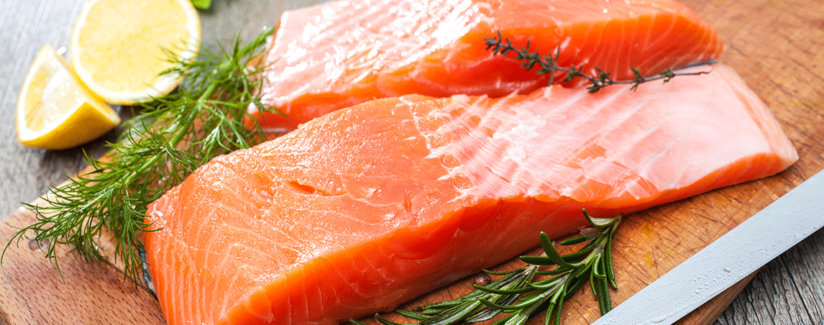
Genetically Engineered Salmon On the Market
10/10/2017
About 4.5 tonnes of fresh AquAdvantage salmon filets have been sold in Canada. The fish are the first genetically engineered animal food product on the market. While some consumers are excited about how the salmon can benefit the environment, others have concerns. Rob Wager, a biochemist and member of the biology department at Vancouver Island University, answered some questions about this new fish.
Is genetically engineered salmon safe to eat?
Wager: “Yes, it is. Extensive testing over almost two decades has clearly demonstrated GE (genetically engineered) salmon has the same nutritional profile as non-GE-salmon of the same species. The FDA in the United States and Health Canada have both stated GE salmon is as safe as non-GE salmon.”
Does it taste the same as other salmon?
Wager: “GE salmon has the same flavour, texture and nutritional aspects as the non-GE Atlantic salmon. Each species of salmon tastes a little different owing to fat content, diet of the species etc. Most consumers enjoy the flavour of all the species of salmon (five Pacific species and Atlantic salmon).”
Dr. Alison Van Eenennaam, Cooperative Extension Specialist, Animal Genomics and Biotechnology at the University of California-Davis, explained in this Best Food Facts article how the fish was developed.
Dr. Van Eenennaam: “Over a quarter of a century ago, a construct that contains a snippet of DNA encoding a growth hormone from the king salmon, connected to DNA regulatory sequences from the ocean pout, was added to the eggs of an Atlantic salmon spawn. A fast-growing fish was selected out of that spawn and was shown to be carrying the construct in its DNA. Since that time, the construct has been stably transmitted through normal inheritance over many generations, in the same way that I passed on my blue eyes to my kids.”
Are there any benefits to the genetically engineered salmon?
Wager: “There are significant benefits to this salmon. Because this salmon grows at twice the rate as non-GE Atlantic salmon, it will consume far less feed to obtain market weight. Salmon feed has small finfish (anchovies and related fish) as a major component. It is clear wild fisheries for small finfish are being overharvested. Therefore, increasing the feed-to-meat conversion rate could help reduce the stress on wild finfish stocks.”
In addition, Wager noted that demand for salmon continues to rise and the new salmon can reduce the harvesting of wild salmon to ensure the continued survival of wild species.
“We cannot protect the wild salmon by eating wild salmon,” he said.
The AquaBounty salmon is farm raised. Can it still be a healthy food if it is farmed, instead of wild caught?
Wager: “Farmed fish is not only safe to eat, salmon is recommended to be a regular part of a healthy diet. Trace amounts of PCB’s and mercury (far below allowable limits) found in wild and farmed salmon are of zero health concern while the levels of heart-healthy omega 3 fatty acids are high in all salmon and highest in farmed Atlantic salmon. Salmon should be a regular part of the diet of pregnant women as the omega 3 fatty acids are essential for fetal neural development. The only significant difference between farmed fish and wild fish is the fat and protein content. Farmed salmon have a slightly higher fat content (which why they contain more omega 3 fatty acid) while wild salmon have a slightly higher protein content.”
What measurements are put in place to prevent the salmon from cross-breeding with native species?
Wager: GE salmon are triploid (three sets of chromosomes compared to the normal two sets ). Triploid organisms are sterile, meaning they cannot reproduce. Other common triploid foods include bananas and seedless watermelons. This added safeguard means that in the very unlikely event of a GE salmon escaping to the wild, it would not be able to breed with wild Atlantic salmon or any other species of salmon.
The salmon will not be labeled as genetically modified. Why?
Wager: “In Canada, we do not label food based on the breeding method used to create the food/crop. Therefore there is no specific label to identify the GE salmon as being a product of genetic engineering. Some feel this hides important facts from the consumer. In Canada we label food for nutritional content and potential allergen content. Neither of these are different for GE salmon and therefore there is no unique label required for this food product.”
He also noted that although the AquaBounty salmon is the first genetically engineered animal food product on the market, Canadians have been consuming foods derived from GE crops for over 20 years.
Wager: “There has never been a documented case of harm from consuming food derived from GE crops. The first GE crops dealt mainly with traits important to the farmer: herbicide tolerance for weed control and insect resistance to reduce insecticide use and yield loss. GE crops allowed farmers to produce more food on the same land with less environmental impact.”
What might this mean for other genetically engineered foods to be introduced?
Wager: “With each year the public is learning more about how GE crops and derived foods are contributing to safe affordable food for Canadians. As the public becomes more familiar with these food products the market will increase the offerings. There are a great many wonderful traits with environmental, economic and health benefits that are working their way through the regulatory system.
“Today we are seeing a new set of GE crops with consumer-oriented traits coming on the market. Better flavour, enhanced nutritional content, bruise resistance, will soon increase the variety of GE crops in the marketplace. In the more distant future GE products like artificial meat, hypoallergenic peanuts, gluten-free wheat etc., may enjoy significant market share.”
Genetically modified salmon are now on the market in Canada. The animals grow more quickly, using less feed so they are a sustainable option. The salmon is safe to eat and offers the nutritional benefits of omega 3 fatty acids. This is the first genetically modified animal food product and may be the first of many that will provide benefits for consumers.



























